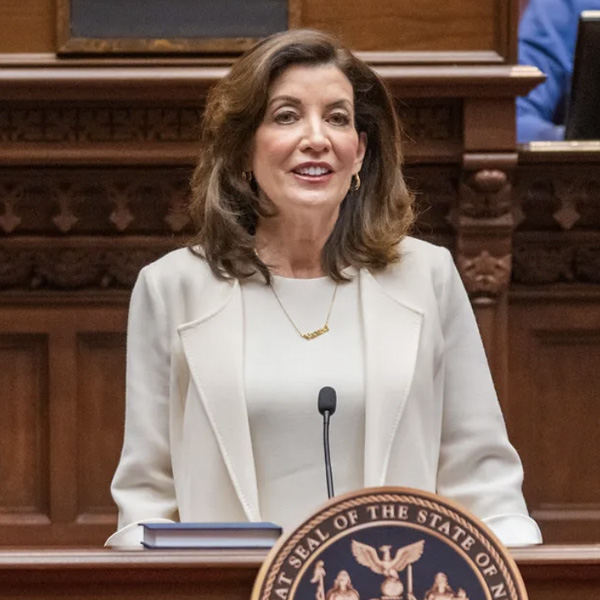Democrats backing aggressive climate policies won or were leading in eight of 12 of the most contested gubernatorial races after voting Tuesday, with Nevada’s Steve Sisolak (D) the only incumbent on the ballot in danger of losing.
Democrat incumbents prevailed in Kansas, Maine, Michigan, New Mexico, New York and Wisconsin, while Democrats also won open seats in Massachusetts and Pennsylvania and were leading in Oregon.
Republican incumbents Gregg Abbott in Texas and Brian Kemp in Georgia also won new terms, while Republican Joe Lombardo, a Las Vegas-area sheriff endorsed by former president Donald Trump, led Sisolak by 50.6%-45.8% with more than three quarters of votes counted.
NEW ENGLAND: Climate-Focused Dems Take, Hold Governorships
Democrats did well in New England on Tuesday, taking back the governor’s office in Massachusetts and holding on against serious challenges in Connecticut and Maine.
Massachusetts Attorney General Maura Healey, who has been widely expected to be the next governor since she announced her run in January, followed through with a comfortable victory over Republican challenger Geoff Diehl.
Healey made climate and energy policy a central plank of her campaign; it was the first policy plan she put out during the primary against progressive challenger Sonia Chang-Diaz.
As AG, Healey is familiar with the work of ISO-NE and the region’s energy landscape. A team from her office is closely involved with the New England Power Pool and have sometimes butted heads with the grid operator over policy matters.
In her campaign climate plan, Healey said she will “work closely with regional partners to ensure that ISO-NE markets for buying and selling power do not discriminate against clean power.” (See Healey Focuses on Climate in Mass. Gubernatorial Race.)
She also said that as governor, she would convene a “regional energy summit” to develop a strategy for addressing transmission, siting, market reform and cost allocation issues.
And the plan goes into much more detail about electrification in the transportation and building sectors, as well as environmental justice and equity.
“Her climate plan meets the critical moment we’re in with the urgency it demands,” said the Environmental League of Massachusetts in a statement. “We’re confident that the Healey administration will make the Commonwealth a national climate leader.”
Maine’s Gov. Janet Mills, who installed solar panels on the governor’s residence when she came into office in 2019 and has pushed for state investment in solar, EVs, offshore wind and more, held on against a challenge from former Republican Gov. Paul Lepage.
One of the biggest issues she’ll have to weigh in on in 2023 is whether Maine should replace its for-profit utilities with consumer-owned, nonprofit utilities. Mills vetoed such a proposal following its passage by the state legislature in 2021 but said her opposition was more about process and specifics of the legislation. (See Maine Voters to Decide on Upending Utility Landscape in 2023.)
In Connecticut, Democratic Gov. Ned Lamont again prevailed in a rematch against his 2018 opponent, Bob Stefanowski.
Lamont has what the Connecticut Mirror reports is a “robust record on climate change,” but also one largely enabled by the Biden administration and the federal government.
Democrat Dan McKee, who took over as Rhode Island’s governor in March 2021, won a full term.
Republicans John Sununu and Phil Scott easily won their races for governor in New Hampshire and Vermont, respectively.
WEST: Democrats Maintain Control in Oregon
In the West, the future of state climate policy was most at risk in Oregon, where the Democratic former speaker of the state House, Tina Kotek, had been locked in a tight race with former Republican House leader Christine Drazan. But local media declared Kotek the winner Wednesday afternoon.
Kotek, who hoped to continue Democrats’ 36-year hold on the governorship, led Drazan 46.2%-44.3% with more than two-thirds of votes counted. Independent Betsy Johnson, a former Democratic state representative, received 8.8%. Most of the uncounted ballots were in the Portland metro area, where Kotek had a strong lead.
A Drazan victory would have upended the decarbonization initiatives that current Gov. Kate Brown (D) implemented through Executive Order 20-04, which set caps on statewide greenhouse gas emissions with the goal of reducing GHGs to 80% below 1990 levels by 2050.
Drazan had promised to “tear up” Brown’s executive order on “Day One” of her term, and also replace the heads of every state agency, each of which has been enlisted in Oregon’s climate efforts. Citing high gasoline prices, Drazan last month additionally pledged to temporarily suspend Oregon’s Clean Fuels Program, which aims to reduce the carbon-intensity of transportation fuels sold in the state. She argued that the 2016 law establishing the program would allow her to do so.
Kotek, on the other hand, has been a leading supporter of climate change policy, having sponsored the legislation behind the Clean Fuels Program and led a Democratic effort to pass a cap-and-trade bill in 2019 (House Bill 2020). HB 2020 faltered after all 11 Republican members of the state Senate refused to show up to the state capitol, preventing the two-thirds quorum needed to vote on the bill. Democratic support for the legislation subsequently weakened, and the bill stalled in committee, prompting Brown to issue EO 20-04 the following year.
In a related development, Oregon voters on Tuesday overwhelmingly approved a ballot measure that would prevent state legislators from seeking reelection if they have more than 10 “unexcused” absences during a session, a development that could improve the ability to pass future climate legislation.
California Voters Reject EV Ballot Initiative
In California, Democratic Gov. Gavin Newsom, who last year easily survived a $300 million recall effort, handily won a second term to lead the nation’s largest state, taking about 58% of the vote. During his first term, Newsom aggressively pushed for California to ramp up its climate goals, and he has worked closely with other leaders on the West Coast to align their decarbonization efforts.
California voters on Tuesday firmly rejected a ballot initiative (Proposition 30) to levy a 1.75% personal income tax on households earning more than $2 million a year to raise $5 billion annually to fund electric vehicle rebates and the installation of EV chargers in public places and at residences. Newsom broke with his party to oppose the measure, saying the state had already committed billions to EV incentives from its budget surpluses.
Arizona Race Too Close to Call
Arizona’s gubernatorial race between Secretary of State Katie Hobbs (D) and former television news anchor Kari Lake was neck-and-neck, with Hobbs leading 50.1%-49.9% with two-thirds of the votes counted.
On the campaign trail, Hobbs has talked about Arizona building “a 21st century clean economy” to address the impact of climate change. She has specifically pledged “to leverage state and federal resources to modernize our energy and transportation sectors;” electrify school buses and state vehicle fleets; provide rural and tribal communities with greater access to sustainable energy; and push for a $200 tax credit for home energy efficiency improvements.
Lake has said that her policies would focus on energy reliability, and while she’s “not opposed to some of the green energy,” she prefers “good old-fashioned clean energy, which is nuclear.” She has stated that she wants Arizona to become an energy exporting “powerhouse” by building modular nuclear reactors that could sell electricity to California, which is subject to brownouts because of its “asinine” policies.
Nevada Incumbents Trailing
Incumbent Democrats were faring worse in Nevada, where Sisolak and U.S. Sen. Catherine Cortez Masto were trailing their Republican opponents Wednesday afternoon, with many mail-in ballots still to be counted. Sisolak was a strong backer of Senate Bill 448, which the Nevada Senate unanimously passed last year to spur major investments in renewable energy transmission, EV charging infrastructure and energy efficiency programs. The law also requires Nevada’s utilities to join an RTO by 2030.
New Mexico Gov. Re-elected
Gov. Michelle Lujan Grisham (D) won re-election in New Mexico with 52% of the vote, outpacing challenger Mark Ronchetti’s (R) 46%.
“The weather forecast for New Mexico is four more years of progress — four more years of rebuilding our beloved state,” Lujan Grisham said in a jab at Ronchetti, a former television weatherman.
The state’s wind and solar resources have increased while coal generation has slowed since the 2019 passage of the Energy Transition Act, which requires the state to get all of its power from zero-carbon resources by 2045. Public Service Company of New Mexico shut down its coal-fired San Juan Generating Station in September in response to the legislation.
Lujan Grisham’s spokesperson has said the governor will focus her second term on policies that diversify the state’s economy and expand renewable energy.
Jeff Byrd (R), who stepped down from the New Mexico Public Regulation Commission to run for land commissioner, came up far short in his bid. He lost to Democrat Stephanie Garcia Richard by a 55-45 margin.
MIDWEST: Clean Energy Goals Undisturbed
Three Democratic incumbents who established clean energy objectives for their states won second terms in Wisconsin, Michigan and Minnesota, leaving decarbonization goals unscathed in the Upper Midwest.
All three incumbents faced Republican challengers who either had ties to the fossil fuel industry or campaigned on prolonging fossil fuel infrastructure.
In late night and early morning victory speeches, the gubernatorial trio promised more work on clean energy adoption or tackling the causes of climate change.
Wisconsin Governor Tony Evers (D), who signed an executive order in 2019 targeting 100% carbon-free electricity in the state by 2050, bested Republican Tim Michels. Michels, co-owner of energy and infrastructure construction company Michels Corp. — which has worked on facilities for the Dakota Access and Keystone XL pipelines and relocation of Enbridge Energy’s Line 5 pipeline in the Great Lakes — said he would divest from his company if elected.
“You showed up for conservation, for clean energy, to take climate change seriously and a future that doesn’t treat protecting our environment and good-paying jobs like they’re mutually exclusive. Because they’re not,” Evers told a crowd in an acceptance speech early Wednesday.
 Michigan Gov. Gretchen Whitmer | City of Detroit
Michigan Gov. Gretchen Whitmer | City of DetroitMichigan Gov. Gretchen Whitmer (D) defeated Republican challenger and Donald Trump pick Tudor Dixon, who vowed to protect the Line 5 project and advocated an “all-of-the-above” strategy for energy production, including reliance on existing coal plants.
Last year, Whitmer introduced the MI Healthy Climate Plan, which calls for economy-wide carbon neutrality in the state by 2050.
In debates, Whitmer and Dixon clashed over the state’s future in electric vehicle manufacturing and whether environmental regulations jeopardize economic progress.
Whitmer vowed in a victory speech that Michigan will “hit the ground running” over her second term, including ramping up the state’s clean energy production.
The Michigan League of Conservation Voters cheered Whitmer’s win on Twitter, saying it was ready to “drive Michigan into a clean energy future” alongside Whitmer.
Finally, Minnesota Gov. Tim Walz (D) overcame a challenge from Republican candidate Scott Jensen, a physician and former state senator. Jensen had campaigned on voiding the state’s clean car rules, overturning a moratorium on nuclear power, and keeping retiring coal plants online longer, including Xcel’s Sherburne County Generating Station, which is due to be replaced in part by solar generation upon its closure in 2030.
Walz thanked campaigners and voters for believing that issues like climate change can be tackled in “an optimistic way that lets us lead the country.”
“Minnesotans have made it very clear. They chose the hopeful future of one Minnesota where we invest in our children, where we defend the rights of individuals, where we address climate change, where we make our communities stronger and where we welcome those seeking the comfort of Minnesota,” Walz said.
Walz in 2019 announced that Minnesota was not on track to shrink emissions 30% from 2005 levels by 2025 and 80% by 2050 per the state’s 2007 law. He issued an executive order to create the Climate Change Subcabinet and the Governor’s Advisory Council on Climate Change to devise strategies to fulfill the reductions targets.
MARYLAND: Moore Pushes State to Go Faster, Bolder on Clean Energy
Maryland’s first and at present the nation’s only African American governor-elect, Wes Moore (D) ran on an aggressive clean energy platform, patterned on President Biden’s ambitious targets and all-of-government approach.
S.B. 528, which became law in April without Republican Gov. Larry Hogan’s signature, has already put the state a path to cut greenhouse gas emissions 60% below 2006 levels by 2031 and to go net-zero economywide by 2045.
 Maryland Gov.-elect Wes Moore | Amunankhra House Ltd.
Maryland Gov.-elect Wes Moore | Amunankhra House Ltd.But calling on Marylanders to go faster, be bolder and not wait for their turn, Moore wants to up the ante, with a 2030 deadline for the 60% emissions reduction. Moore also wants the state running on 100% clean energy by 2035, “by leveraging billions of incoming federal funds and growing solar installations, supercharging Maryland’s wind industry, and investing in battery storage research and development within our university systems.”
He calls for an “entire-government” approach in which all state government agencies will review of their procurement and energy efficiency standards and their vehicle fleets, with the goal of setting “clear annual benchmarks that will reduce their environmental impact and that of the state.” He also wants the state’s vehicle fleet electrified by 2030.
Like Biden, Moore sees the green economy as creating jobs and promoting equity, especially for low-income families, and he intends to appoint a chief sustainability, mitigation and resilience officer to oversee and coordinate the state’s clean energy and climate initiatives.
But, even with plenty of federal funds from the Inflation Reduction Act and solid Democratic majorities in both the Maryland House of Delegates and Senate, Moore’s plan could face obstacles. Exelon, which owns the state’s two main utilities, Pepco and Baltimore Gas and Electric, has a 2050 target for net-zero emissions. According to the U.S. Energy Information Administration, as of July, coal and natural gas were still providing close to two-thirds of the state’s electricity.
Successive efforts to pass a green building code in the state have been watered down or derailed by the local building industry.
For example, S.B. 528 originally contained provisions requiring that from 2023 to 2033, at least one new school in each school district be built to net-zero standards, but the provisions were cut from the final version.
The bill’s broader requirements on building performance standards were another casualty. They would have mandated that new or renovation projects built with at least 25% state funding meet high-performance building standards developed by the Maryland Green Building Council. Emission-reduction targets for large commercial buildings and multifamily dwellings were also cut, from 50% to 20% in 2030, and a net-zero target for 2035 was eliminated.
A U.S. Army vet and nonprofit executive, Moore has no previous experience in government. On the plus side, he will come into office backed up with a slate of experienced Democratic government officials, including U.S. Rep. Anthony Brown as attorney general and state Del. Brooke Lierman as comptroller.
NEW YORK: Voters Approve $4.2B Environmental Bond
New York state voters approved $4.2 billion in environmental and climate protection spending by a huge margin Tuesday but retained the governor leading the climate effort by a much closer vote.
The Clean Water, Clean Air, and Green Jobs Environmental Bond Act of 2022 promises extensive capital improvements in coming years, with up to $1.5 billion of the funds designated for climate change mitigation.
 New York Gov. Kathy Hochul | Darren McGee, Office of Governor
New York Gov. Kathy Hochul | Darren McGee, Office of GovernorSpecific spending includes $400 million for green building projects at state-owned facilities and public schools; $200 million for reduction of air and water pollution affecting environmental justice communities; and $500 million for purchase of zero-emission school buses and supporting infrastructure.
As of midday Wednesday, unofficial results showed voters supporting the environmental bond on 59% of ballots cast and opposing it on 29%, a ratio slightly better than 2-to-1. (No vote was cast on the other 12% of ballots, some undoubtedly because the proposition was on the back of the ballot and went unseen.)
By contrast, Democrat Kathy Hochul collected 52.2% of votes for governor to Republican Lee Zeldin’s 47%.
As of Nov. 1, Democrats outnumbered Republicans among registered voters 49.6% to 22.1%.
Hochul’s predecessor, Andrew Cuomo, was a forceful advocate of efforts to slow climate change, and Hochul continued support for one of the nation’s most aggressive decarbonization programs after she took over as governor in mid-2021.
But the transformative (and expensive) climate initiatives never became a major Democrat-vs.-Republican theme during the 2022 campaign season in New York. And the bond act was approved by a margin wider than that enjoyed by almost every winning candidate for state office.
With both chambers of the legislature retaining a Democratic majority if not supermajority going into 2023, the state appears on track to continue with what Hochul likes to call its “nation-leading climate agenda.”


